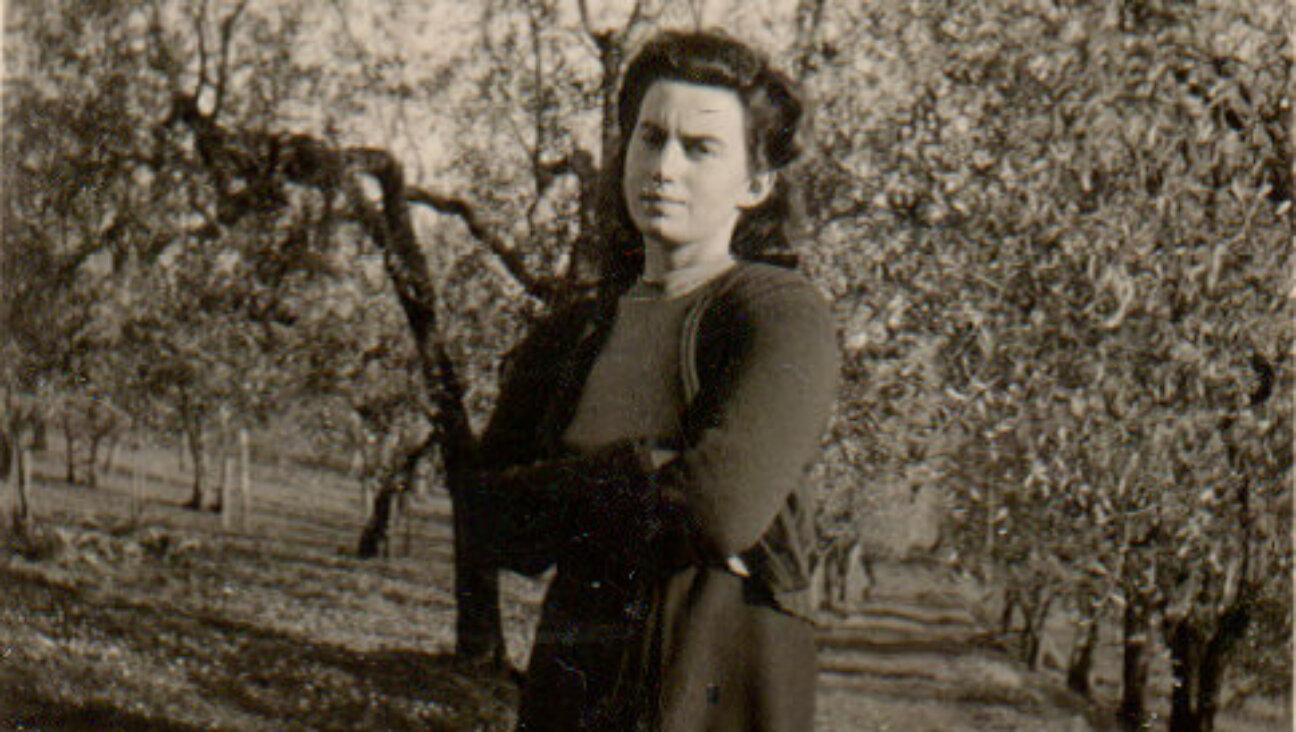June 6, 2003
Hadassah’s First Cook Book, Cornhusks ’n All
A May 30 article identifies the Hadassah in Dorchester, Mass., as having been, in 1931, the first chapter in the United States and Canada to publish a cookbook (“Happy Holidays from Hadassah”).
That distinction rightly belongs to the 25 women of Omaha, Neb., who worked in 1927 on the “Hadassah Kosher Cook Book” that appeared in 1928.
The charitable cookbook raised funds for Hadassah’s worthy causes. Advertisers included the National Laundry Co.; Peoples Coal Co.; Butter-nut Coffee; Baker Ice Machine Co.; Omar Baking Company; the local Reo Flying Cloud; Red Wolverine and Reo Speed Wagon car dealership; Ernest Buffet Buy-Rite Grocer (a relative of Warren Buffett, head of Berkshire Hathaway), and Pittsburg Plate Glass Co. These were typical of the businesses catering to the housewife. The women sold the cookbook for one dollar.
Ninety-three-year-old Saul Graetz has been married to Esther since 1934. He thinks the cheese torte recipe comes from his grandmother. Other recipes in this 87-page book include, in their 1928 spelling, Lukshen Taigachtz, Mandelbrait, Shaltanosis, Gefulte Fish, Kreplach, Flomen Tsimas, Varenikes with Buckwheat Gritz, and Borsht. Most Hadassah cookbooks are kosher.
Despite the small size of Nebraska’s Jewish population, it has produced over 25 Jewish charitable cookbooks, and has several Forward readers.
Oliver Pollak
Department of History
University of Nebraska at Omaha
Omaha, Neb.
Common Black-Jewish Theology Overstated
Opinion writer Rabbi Shmuley Boteach argues in generalities sprinkled with absurdities in order to claim spiritual commonality between Jews and blacks (“The Enduring Relevance of Black-Jewish Relations,” May 23).
His main arguments are that most religions teach about the primacy of the afterlife, whereas Jews and blacks emphasize this life; and that, unlike people of other faiths, Jews and blacks rejected the divine right of kings on the grounds that “no man is born subject to another, for all men were princes.”
To claim that black people were taught that “no man was born subject to another” is completely absurd. Of course black people were taught that they were subject to and inferior to whites. Nearly a century and a half after Abraham Lincoln’s “Emancipation Proclamation,” many black people are still saddled with the psychological effects of that awful teaching.
There was indeed a glorious time in America when some Jews joined hands with blacks. I agree with Boteach that both groups were animated by the notion that God wants people to be free. In the person of Martin Luther King Jr. and some other brave leaders, the moment arrived by which that first principle could be fought for and won. Jews, as outsiders, as people who knew the taste of oppression, were more motivated to join the struggle than white non-Jews.
But to claim a commonality in Jewish theology and black theology is much too simplistic, much too general, and much too misleading.
Rabbi Stephen Listfield
Agudath Israel Eyz Ahayem Synagogue
Montgomery, Ala.
Rabbi Shmuley Boteach misses the mark in his May 23 opinion article, as did Samuel Freedman in his May 30 letter responding to Boteach’s piece.
Since its inception at the turn of the 20th century, the relationship between the two communities has ranged from love to hate, friendship to animosity, and at times is in the middle of those two extremes.
It can only be said with historic certainty that black-Jewish relations is, pardon the pun, not that black and white.
Marvin Weitz
Professor, Black-Jewish History
Touro College
New York, N.Y.
‘Branded’ Female Pride
The “Jewlo.com” Web site profiled in the May 23 East Village Mamele column is the biggest pile of garbage disguised as Jewish pride I have ever seen (“Yidishe Hotties, Unite”).
What insecure people these must be that they have to use “Jew” as a brand rather than a belief. Being Jewish to me is a fact, not a brand name or a trademark. As for the Jewish women who are finally finding their sexuality, I have never known a proud Jewish woman who is not sexually aware of herself as a confident sensual woman. Unfortunately, the Mamele column seems to equate sexuality with promiscuity.
There have been many beautiful Jewish women in the arts and media who never hid the fact that they were Jewish. And they didn’t have to wear the word “Jew” on a T-shirt to remind themselves who they are. Evidently these “new babes” can’t seem to remember that they’re Jewish without it being printed on their clothes.
Simon Rutberg
Los Angeles, Calif.
Oversimplifying Iran
The words used by media to describe the situation in Iran must be most carefully chosen (“Look Who’s Talking Iranian Democracy: Son of the Late Shah,” May 30).
The Forward repeats the claim that the last shah of Iran “came to power via an American-backed coup in 1953 that ousted Iran’s democratically elected prime minister, Mohammad Mossadegh.” Over and beyond playing into the hands of conspiracy-theory mongers who are always willing to blame someone else for their own misery, the facts presented by the Forward are not to pass uncritically.
In the effort to oversimplify matters to make Iranian history understandable to less-than-interested parties who see things better in good and evil binaries, often overlooked is the fact that Mossadegh was actually a prince of the older dynasty toppled at the hands of the father of the shah, Mohammad Reza Shah Pahlavi. Mossadegh was a Ghajar prince no matter how well he played the role of the “man of the people.”
The shah did not “come to power” in 1953. Mossadegh, by overtly threatening the shah and the internal security of the state during the early years of the Cold War, essentially took away the relevancy of a loyal opposition and made all opposition militant and non-cooperative. This, joining together with the pre-modern voices emanating out of the mosques and the anti-liberal militant forces of the extreme left, found its resonance in 1979 and led to the state of affairs as we have them today.
All this is not meant to say that Mossadegh was bad or that the shah was good; it is rather to point out that things are never as simple as some of the news articles on the matter make it seem.
Amir Irani-Tehrani
New York, N.Y.
Liberal (Orthodo)X-Men
The May 23 article on the “X-Men” film compares the violent parochial tactics of the movie’s mutant villain Magneto to Rabbi Meir Kahane’s militant Zionism, and the non-violent acculturationist strategy of the movie’s mutant educator Charles Xavier to Rabbi Irving Greenberg’s theological response to the Holocaust (“(Orthodo)X-Men”).
Although these characterizations are interesting, they ignore the intentions of the creators of the X-Men series and of the makers of the movie. Both Stan Lee, nee Stanley Lieber, and Jack Kirby, nee Jacob Kurtzberg, belong to the generation of American-born children of Jewish immigrant parents. Their early comic book superheroes battled Hitler and Nazism even before the United States entered World War II. Both men served in the U.S. Army. Kirby was deeply shaken by the corpses and emaciated survivors he encountered at a small labor camp his unit liberated. Kirby and Lee launched “X-Men” in 1963 at the height of the civil rights movement.
Identifying with its goals of equality before the law, Lee penned a column affirming his commitment to “judging each fellow human on his own merit, regardless of race, creed, and color.” The executive producer of the “X-Men” movies has characterized the ideological and tactical conflict between Charles Xavier and Magneto as analogous to the divisions between Martin Luther King Jr. and Malcolm X.
Since Xavier recognizes that the superpowers of the mutants will frighten ordinary human beings, he runs a school where young mutants can learn to harness their powers to benefit humanity. He advises his pupils to assimilate into their host society and gain acceptance on the basis of their social utility. This position mirrors the Jewish liberal ideals embraced by the majority of members of Kirby’s and Lee’s generation.
In the comic book series, Xavier first met Magneto in Israel where the latter worked in a psychiatric hospital for Holocaust survivors, but relating the movies to current debates over Israel strains this analogy. Instead, the two movies consciously evoke parallels with McCarthyism, homophobia and immigrant restrictionism.
Indeed, the concluding scenes of the first movie are shot at the Statue of Liberty and Ellis Island, where the United Nations is meeting to debate government registration of mutants. The opening of the sequel cites one of Abraham Lincoln’s calls for tolerance between different peoples. Although director Bryan Singer made an earlier movie about the Holocaust, “Apt Pupil,” there are no overt references to the Jewish ordeal in the most recent “X-Men” movie. As Singer has articulated in an interview, “the underlying philosophy of ‘X-Men’ is that the notions of prejudice and fear are universal.”
Lawrence Baron
Professor
San Diego State University
San Diego, Calif.
The Forward is free to read, but it isn’t free to produce

I hope you appreciated this article. Before you go, I’d like to ask you to please support the Forward.
Now more than ever, American Jews need independent news they can trust, with reporting driven by truth, not ideology. We serve you, not any ideological agenda.
At a time when other newsrooms are closing or cutting back, the Forward has removed its paywall and invested additional resources to report on the ground from Israel and around the U.S. on the impact of the war, rising antisemitism and polarized discourse.
This is a great time to support independent Jewish journalism you rely on. Make a gift today!
— Rachel Fishman Feddersen, Publisher and CEO
Support our mission to tell the Jewish story fully and fairly.
Most Popular
- 1

Fast Forward Ye debuts ‘Heil Hitler’ music video that includes a sample of a Hitler speech
- 2

Opinion It looks like Israel totally underestimated Trump
- 3

Culture Cardinals are Catholic, not Jewish — so why do they all wear yarmulkes?
- 4

Fast Forward Student suspended for ‘F— the Jews’ video defends himself on antisemitic podcast
In Case You Missed It
-

Culture How one Jewish woman fought the Nazis — and helped found a new Italian republic
-

Opinion It looks like Israel totally underestimated Trump
-

Fast Forward Betar ‘almost exclusively triggered’ former student’s detention, judge says
-

Fast Forward ‘Honey, he’s had enough of you’: Trump’s Middle East moves increasingly appear to sideline Israel
-
Shop the Forward Store
100% of profits support our journalism
Republish This Story
Please read before republishing
We’re happy to make this story available to republish for free, unless it originated with JTA, Haaretz or another publication (as indicated on the article) and as long as you follow our guidelines.
You must comply with the following:
- Credit the Forward
- Retain our pixel
- Preserve our canonical link in Google search
- Add a noindex tag in Google search
See our full guidelines for more information, and this guide for detail about canonical URLs.
To republish, copy the HTML by clicking on the yellow button to the right; it includes our tracking pixel, all paragraph styles and hyperlinks, the author byline and credit to the Forward. It does not include images; to avoid copyright violations, you must add them manually, following our guidelines. Please email us at [email protected], subject line “republish,” with any questions or to let us know what stories you’re picking up.















